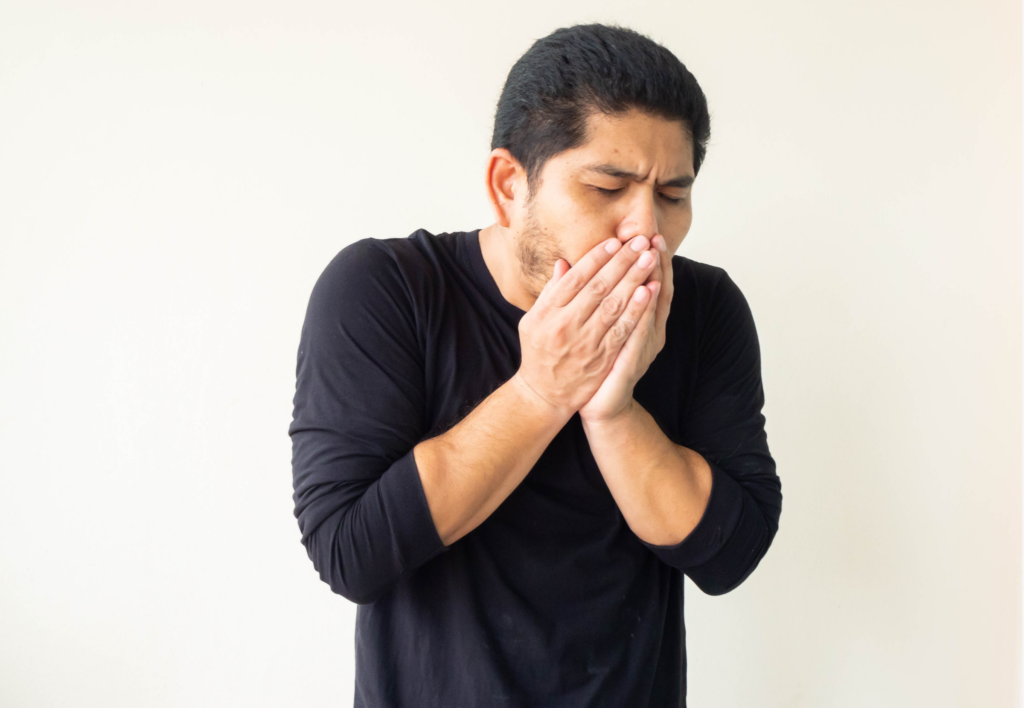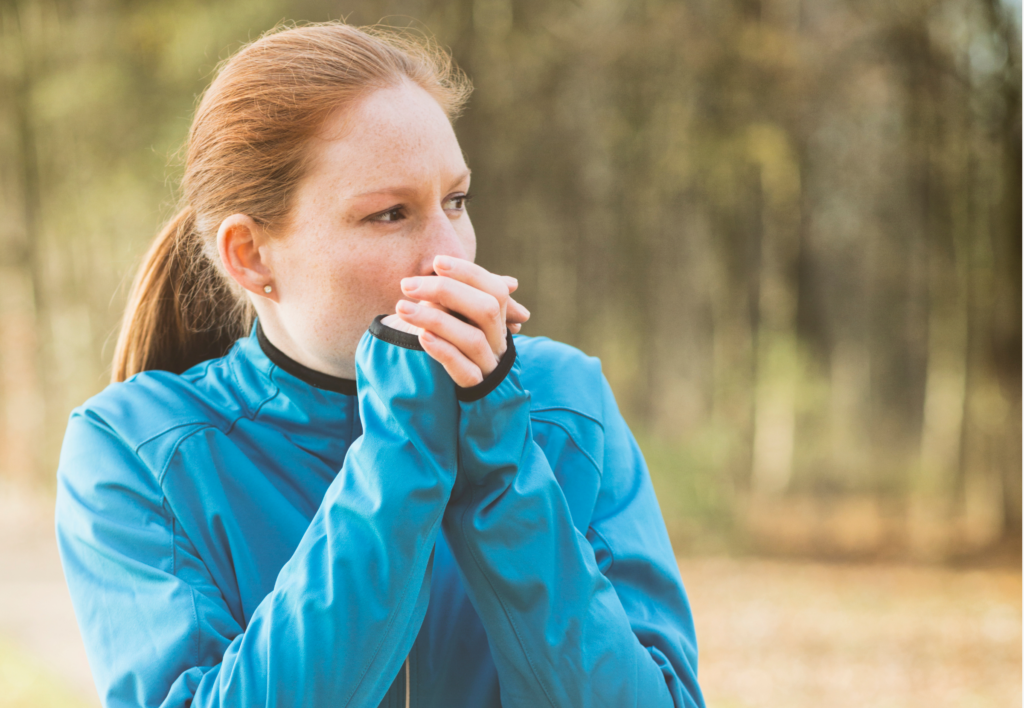How to Avoid ‘Runner’s Cough’ in the Winter Months (Breathing Techniques & Prep)
Alongside the invigorating rush of cold-weather runs comes a less welcome companion: the ‘runner’s cough’. This post-run hack can be both annoying and discomforting, often lingering long after you’ve unfurled from your layers of activewear.
But what exactly causes that persistent cough after you’ve stopped tracking your miles? And more importantly, how can you prevent it from becoming part of your winter running routine?
This blog post will explore practical tips and strategies to help you avoid ‘runner’s cough’, ensuring your runs are as clear and comfortable as the winter sky.
What Is ‘Runner’s Cough’ Exactly?
‘Runner’s cough’, often characterized by a persistent dry cough following a run in cold weather, is a common complaint among winter athletes. Symptoms may include a scratchy throat, a wheezing cough, and sometimes even chest tightness. But why does it occur?
When you breathe in cold, dry air, your airways respond by narrowing, which can trigger a cough reflex. This is a defense mechanism of the body, aiming to protect the delicate tissues in the lungs from the cold air. Moreover, the dryness of the winter air can deplete the moisture in your airways, leading to irritation and coughing.
Real-world data from sports medicine studies suggest that ‘runner’s cough’ is quite common, with many outdoor athletes experiencing some form of respiratory discomfort after exercising in cold temperatures. However, it’s important to differentiate ‘runner’s cough’ from other types of coughs, such as those resulting from a cold or asthma, as the management may differ.

Pre-Run Preparation to Avoid Runner’s Cough
Preparation is key to preventing ‘runner’s cough’.
Before you step out into the frosty air, take the time to do a dynamic warm-up indoors. This increases your core temperature and blood flow, which in turn, helps your lungs to better adapt to the change in conditions once you step outside.
Dressing appropriately can also make a significant difference. A scarf or a mask, for example, can act as a barrier that warms and humidifies the air before it enters your lungs, reducing the shock of cold air on your respiratory system.
While a buff or other mouth covering won’t really warm the air up significantly, they trap moisture when you exhale and help moisten the air as you run. Just be sure to wash this accessory after every run because you are creating a breeding ground for bacteria!
Remember, the goal of your pre-run preparation is to minimize the shock of cold air to your system, setting you up for a more comfortable and cough-free run.
By understanding and implementing these strategies, you can help ensure that your winter runs are marked by the beauty of the season, rather than the discomfort of ‘runner’s cough’.

Breathing Techniques To Use During Your Run
Adopting proper breathing techniques can play a crucial role in mitigating the impact of cold air on your respiratory system.
Here are some practical tips to help you breathe more effectively during your winter runs:
- Nasal Breathing: This technique involves breathing in through your nose and out through your mouth. The nasal passage warms and adds moisture to the air before it reaches your lungs, reducing the likelihood of irritation. It may take practice to maintain nasal breathing during high-intensity workouts, but it’s worth the effort for the protective benefits it provides.
- Controlled Breathing: Try to establish a rhythmic breathing pattern that syncs with your stride. For example, you might inhale for three steps and exhale for two. This controlled approach can help prevent hyperventilation, which often occurs when you’re gasping for air in the cold and can lead to coughing.
- Diaphragmatic Breathing: Also known as “belly breathing,” this technique involves engaging your diaphragm as you breathe, which allows for deeper, more efficient breaths. By maximizing the air entering your lungs, you reduce the work of breathing in cold air and the potential for coughing.
Practicing these techniques during your runs not only helps in preventing ‘runner’s cough’ but also improves your overall respiratory efficiency, which can enhance your performance.

Post-Run Best Practices to Avoid Runner’s Cough
What you do after your run is just as important as your pre-run preparation when it comes to preventing ‘runner’s cough’. Here are some key strategies to implement:
- Cool Down Properly: Gradually reducing your pace towards the end of your run allows your breathing rate to decrease slowly, reducing the stress on your respiratory system. Follow up with some indoor stretching to keep your body temperature from dropping too quickly.
- Stay Warm: After completing your run, change out of cold, damp clothes as soon as possible to prevent a drop in body temperature, which can lead to coughing. Keep your throat and chest area warm with a scarf or neck gaiter.
- Hydrate and Moisturize: Even though you might not feel as thirsty in cold weather, it’s essential to replenish fluids to maintain mucosal lining in the respiratory tract. Also, consider using a humidifier in your home to add moisture to the dry winter air.
By incorporating these post-run practices into your routine, you can help soothe your respiratory system and prevent the onset of ‘runner’s cough’, making your winter running experience much more enjoyable.
Environmental Considerations – Wind and Temperature
Running in cold weather doesn’t have to be a chilling experience for your lungs. Paying attention to the environment and timing can make a significant difference.
Here are a few considerations to keep in mind:
- Choose the Right Time: Midday tends to be the warmest part of the day during winter, so plan your runs when the sun is likely to be out. This can mean a few degrees’ difference, which can be kinder to your respiratory system.
- Mind the Wind: A windy day can exacerbate the effects of cold air and lead to more severe ‘runner’s cough’. Try to run on less windy days or plan a route that is sheltered from the wind.
- Monitor Air Quality: Cold air can trap pollutants close to the ground, leading to poor air quality that can irritate the lungs. Check the air quality index before heading out and opt for indoor workouts when levels are high.
- Acclimate Your Lungs: Gradually increase your exposure to cold weather running. This can help your respiratory system adapt over time, making it less likely to react negatively to the cold air.

Long-Term Strategies to Prevent ‘Runner’s Cough’
In addition to immediate strategies, there are long-term approaches you can take to strengthen your respiratory system and reduce the occurrence of ‘runner’s cough’.
Here are some tips:
- Strengthen Your Respiratory Muscles: Just like any other muscle group, your respiratory muscles can benefit from targeted exercises. Incorporating breathing exercises into your daily routine can increase lung capacity and control.
- Stay Consistent with Your Running: Regular running throughout the year, including the colder months, can help your body adapt to different conditions, making it less likely to react adversely to seasonal changes.
- Maintain a Healthy Lifestyle: A strong immune system can fend off the colds and infections that can worsen ‘runner’s cough’. Prioritize good nutrition, adequate sleep, and stress management to keep your immune system robust.
By taking these environmental factors and long-term strategies into account, you can help ensure that your winter running is both enjoyable and free from the discomfort of ‘runner’s cough’. Remember, a proactive approach to your health and running practice is the best defense against the challenges of cold-weather running.
When to Seek Medical Advice for Runner’s Cough
While ‘runner’s cough’ is generally benign and temporary, it’s important to be vigilant about your health and know when to consult a healthcare professional.
Here are some instances when you should seek medical advice:
- Persistent Symptoms: If your cough lingers for more than a few days after your run, it could be a sign of a more serious condition, such as bronchitis or asthma.
- Worsening Conditions: If you notice an increase in the severity of your symptoms, such as difficulty breathing, wheezing, or chest pain, it’s essential to get checked out by a doctor.
- Pre-existing Respiratory Issues: If you have a history of respiratory conditions like asthma, it’s crucial to work with your healthcare provider to manage your condition and adjust your running routine accordingly.
- Unusual Symptoms: Symptoms like fever, chills, or producing mucus could indicate an infection rather than just ‘runner’s cough’ and should be evaluated by a healthcare professional.
Remember, it’s always better to err on the side of caution when it comes to your health. Don’t hesitate to reach out to your doctor if something doesn’t feel right.
Conclusion
‘Runner’s cough’ can be an unwelcome side effect of cold-weather running, but with the right strategies, you can minimize its impact or prevent it altogether.
From warming up indoors to mastering breathing techniques and dressing appropriately, each step you take can contribute to a more comfortable running experience. Post-run practices like cooling down properly and staying warm are equally important in keeping ‘runner’s cough’ at bay.
By understanding the environmental factors that can exacerbate ‘runner’s cough’ and adopting long-term strategies to strengthen your respiratory system, you can enjoy the crisp winter air without the cough. And remember, if your symptoms persist or you’re unsure about your health, it’s important to seek medical advice.
Running in the winter has its unique set of challenges, but with preparation and care, you can continue to hit the pavement and enjoy the serenity and beauty that winter running has to offer. Stay warm, stay safe, and keep running!






